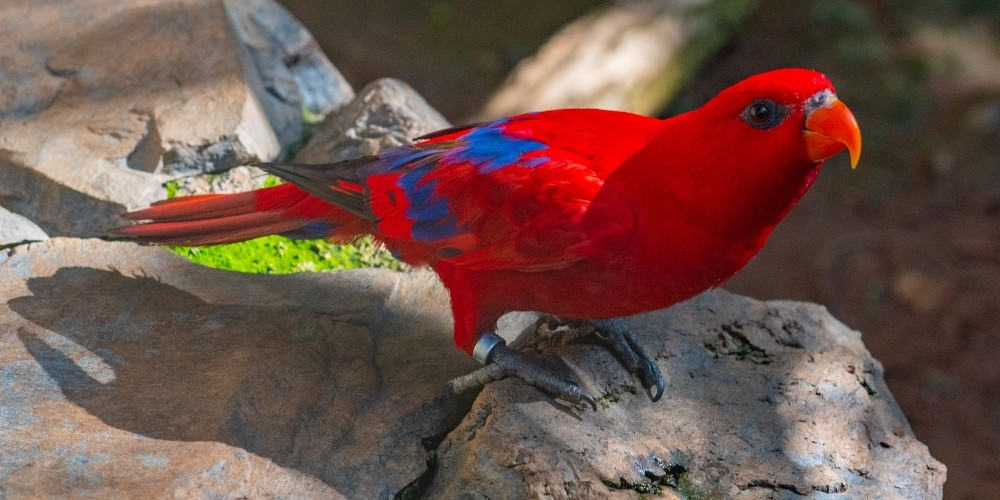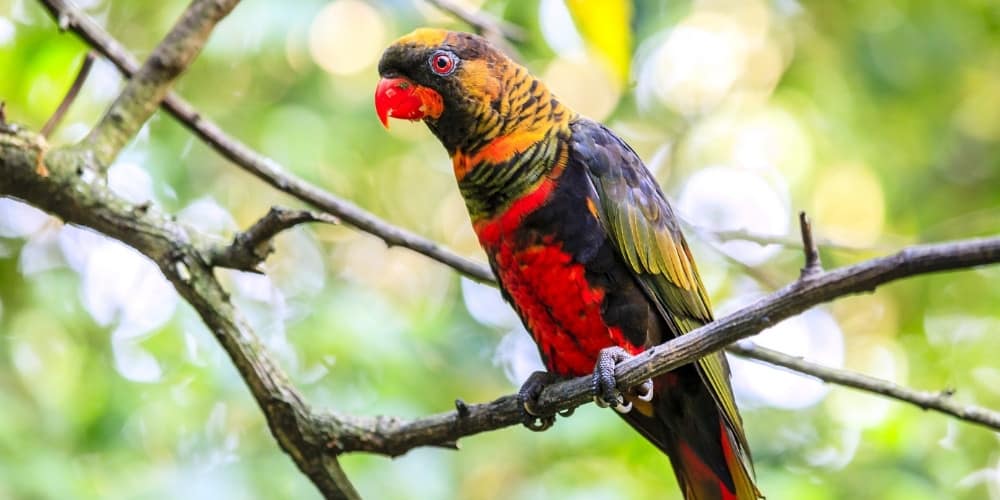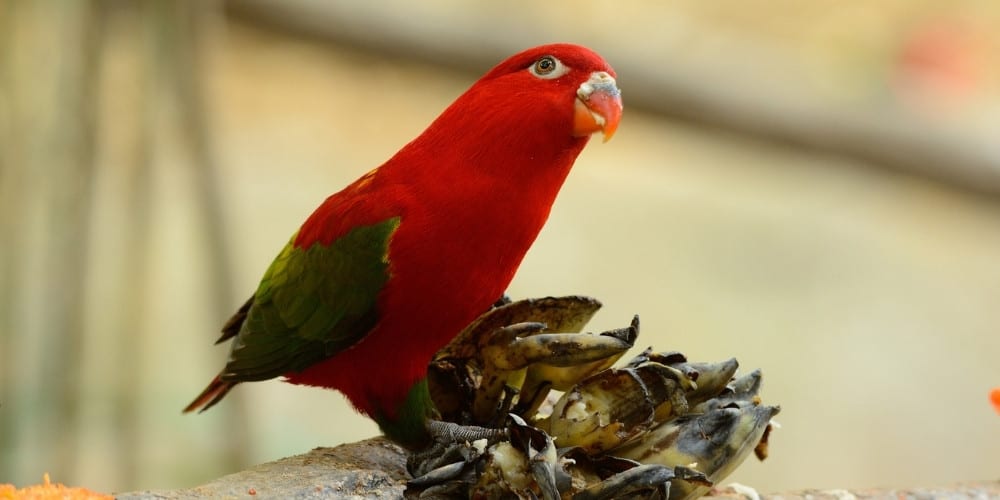Lories are some of the most visually appealing parrots out there. They come in a variety of colors with personalities to match.
Lories (and closely related lorikeets) are unique among parrots because their diet consists mainly of nectar from flowers.
Are lory birds good pets? Lories can be excellent pets for those with prior parrot experience and those willing to accommodate their specific dietary needs. They are capable of talking and forming strong bonds with humans, but they can be fairly noisy as they love to chatter and can be too inquisitive at times.
Those who are able to provide proper care for a lory bird receive a comical and fun-loving companion in return.
Bird enthusiasts enjoy keeping lories for their unique diet and energy levels. Ready to learn more? Let’s get started!
Lory Bird Facts
Known as “honeyeaters” or “brush-tongued parrots,” these vibrant birds stand out among parrots in several ways.
Lory Appearance & Size
Lories are medium-sized parrots, and each species has different plumage. Almost all lories are brightly colored.
Their beaks are slightly different from most “hook bills” in that they are narrower and the top bill comes to a tighter point.
Males and females look the same, so DNA testing is required to determine the gender.
Lory Temperament and Personality
Lories are known for their playful personalities and energetic disposition.
They are known for exhibiting silly behaviors, like rolling in a blanket to go to sleep or hanging upside down from their owner’s clothes.
In a lory’s world, everything is a toy and meant to be played with.
Lory Native Region & Habitat
Lories are native to the region of Australasia, which includes Australia and the surrounding southeast Asian islands.
They are arboreal birds and are found in forests and mangroves. Unfortunately, wild lories are losing much of their habitat to deforestation for logging and agriculture.
Most lories are somewhat nomadic in order to find food. They will travel throughout their habitat to find the plants that are blooming during each season.
Lories can feed on the pollen and nectar of over 600 flowers per day. That’s pretty amazing!
Lory Intelligence & Trainability
Like all parrots, lories are considered to be very intelligent birds.
They are capable of talking and learning many behaviors, which is why they are commonly seen in bird shows at zoos.
Are Lories Smart?
There is no doubt that lories are intelligent animals. They are fast learners and do well in training sessions.
Their intelligence can also get them into trouble, as they can figure out how to open their cage or get into something they shouldn’t.
Are Lories Easy To Train?
Lories are easy to train once you find the correct reward for them.
Since they do not typically eat seeds and nuts, the most popular rewards for parrot training, owners have to get creative when training their lory.
Some have success with honey water, nectar pellets, small pieces of fruit or small berries.
Because of their smart and inquisitive nature, lories are capable of learning new behaviors very quickly.
They seem to enjoy the challenge of learning a new behavior and interacting with their owner.
Some lories have even been “potty trained,” learning to eliminate their waste in one section of their cage.
In our article on caique parrots, an avian expert shares her advice on housebreaking a pet bird. Be sure to check it out.
Lory Sounds & Vocalizations
Lories might not reach the same decibels as cockatoos and some macaws, but they are still considered to be loud birds.
Usually, they can be heard chattering with the occasional squawk or screech.
These birds are capable of learning and repeating words and phrases, but their voice is extremely high pitched.
The following video of a red lory talking extensively and mimicking a cat’s meow will absolutely amaze you.
Lory Care
It is important to consider the needs of a lory before purchasing one as a pet. Since they are a unique group within parrots, their requirements are different from other birds.
Ideal Pet Lory Diet
In the wild, lories survive almost exclusively on nectar and pollen from flowers. Occasionally, they will eat the entire flower or ripe fruit.
As a pet, lories should still be consuming a mostly liquid diet.
For many years, lory owners tried to make their own nectar mixtures, but they were unsuccessful in matching the nutrient requirements of the birds.
Luckily, owners can now buy commercially made nectar powders, like this dry mix made for lories, lorikeets, and hummingbirds.
These powders are simply mixed with water to create a food source for the lory.
One challenge with a liquid diet is that the birds digest it quickly and need to eat frequently throughout the day.
During warm months, nectar should be replaced at least every 4 hours to avoid spoiling. This can be a lot of work for the owner.
One option is to feed a dry nectar formulation, such as this gourmet mix on Amazon, and have plenty of available water nearby.
Lories should never have more than 15% protein in their diet, so the only foods they should eat in addition to nectar are fruits and flowers.
Safe flowers include roses, hibiscus, pansies, nasturtiums, dandelions, and marigolds.
Avoid avocados due to their toxicity and pomegranates because some lories have become impacted after eating them.
An Expert’s Opinion
I recently spoke with veterinary technician Joanne from Stahl Exotic Animal Veterinary Services about a vet-recommended diet for these beautiful birds.
She shared the following after consulting with several of the doctors:
The powdered nectar is going to be easier to deal with as it will not spoil nearly as quickly and will be less messy overall.
Nutritionally, it will provide the same results as the liquid versions, as long as you purchase a vet-recommended brand and steer clear of the cheaper formulations that tend to be mostly sugar.
Be aware that the powdered options can spoil too, and it may be wise to store them in the fridge or freezer in air-tight containers.
Also, because the food is so sugary, it’s important to thoroughly clean all food and water dishes regularly to avoid the buildup of bacteria and mold.
Housing Requirements
Lories should be housed in the largest cage possible, as they are constantly moving. At minimum, a cage should be 3 feet wide by 4 feet tall.
They need space to fly, perch, climb, and play. If your location and weather permit, lories thrive in an outdoor aviary where they have plenty of space to move around.
Lories are extremely messy birds. They are known for splashing and spilling their liquid diet.
Additionally, their waste is mostly liquid, and they are capable of shooting it long distances.
It is advised to have your cage in an area that is easy to clean. Some owners use clear acrylic on the wall behind the cage to make for easier cleaning.
Lory cages must be cleaned every day. Due to the amount of liquid food and waste, bacteria and yeast can easily grow and infect the lory.
Replace nectar frequently and maintain a clean cage for the health of your lory.
Exercise
These birds are always moving and need regular exercise. It is in their nature to be high energy and will therefore need an outlet for that energy.
Outdoor aviaries allow lories to have the space and a safe environment to move as they need.
If your lory is only housed indoors, they should have a few hours per day of supervised playtime outside of their cage.
They will enjoy climbing all over their owner and getting into anything interesting. Lories also love splashing around in a shallow bath.
Stimulation
Like most parrot species, lories enjoy and need interaction with their human family. This socialization is vital in keeping the lory from getting bored and lonely.
Without human socialization, these birds can be nippy and standoffish. Therefore, it is preferred to hand-rear chicks to begin socializing them as early as possible.
Lory Price
Lory birds can cost between $500 and $1,500 depending on the species and breeder.
Adopting a rescue bird is usually a cheaper option, but there is always the chance that the bird has not been properly cared for and/or socialized and will require a good deal of effort on your part.
Lory Lifespan
Lories can live up to 30 years in human care.
The most important factors that contribute to a long life are an appropriate diet, clean living conditions, and sufficient exercise.
Lory Interesting Facts
- Lories and lorikeets belong to different genera within the same family of parrots, even though they are often mistaken as being the same type of bird.
- In Australia, all lories and lorikeets are called lories colloquially.
- Lories are one of the few types of parrots that prefers to be housed alone and does not get along with other birds.
Types of Lories Commonly Kept as Pets
There are more than 15 species of lories, but only a few are commonly found as pets.
Black Lory

Black lories have some of the most unique plumage among lories. They are mostly black with some yellow and orange feathers on their tail.
They have a reputation as being one of the friendliest lory species.
Red Lory

The red lory is the most common lory bird found as a pet.
It is mostly red with black around the eyes and on the wings. Around the neck and wings, a few vibrant blue feathers can be seen.
Dusky Lory

“Duskies” as they are affectionately known, are a favorite lory for bird enthusiasts but are not as common as a pet.
Their feathers are a variety of colors, including red, yellow, blue, and green, but they are more muted than most other lories.
Black-Capped Lory

As its name suggests, the black-capped lory has black feathers on its head. The body is blue and red with green wings. This is one of the larger lory species.
Chattering Lory

Chattering lories are mostly red with yellow and green on the wings. There is some black on the wings and the tip of the tail.
They are excellent at mimicking sounds, even household noises like alarm clocks and ringtones.
Which Lories Make the Best Pets?
All lories require similar care, so one species is not necessarily easier than another. Red lories are the most common, so it is easier to find a breeder and other owners.
Do Lory Birds Talk?
Lory birds can indeed talk. They have high-pitched voices and are capable of learning and repeating many words.
Their words are not quite as clearly spoken as with other parrots, but they are certainly decipherable, and some lories are quite easy to understand.
Do Lories Make a Lot of Noise?
Lories are almost constantly chattering, so they make a lot of noise.
While they may not be as loud as macaws or cockatoos, they are most likely not a good option for apartment living.
Are Lories Messy?
Lories are one of the messiest parrots. They have a tendency to spill their nectar and water due to the way they lap with their tongue.
Additionally, their liquid diet creates liquid waste that gets all over their cage and surrounding area.
Some owners claim that feeding dry powdered nectar helps to solidify the droppings somewhat.
Are Lories Good for Beginners?
Lories are not considered to be good birds for beginners. Due to their high energy and specialized diet, lories are recommended pets for experienced bird owners.
The owner should be able to commit to the time needed for cleaning, playtime, and replacing nectar frequently.
Is a Lory a Parrot?
Both lories and their close relatives, lorikeets, are true parrots.
Like all parrots, they have a curved beak and feet with two toes pointing forwards and two pointing backwards, but they are unique among parrots due to their brush-shaped tongues and diet of nectar.
Are Lories the Same as Lorikeets?
While lories and lorikeets are very similar birds, they belong to different genera within the same family.
Lories tend to be larger and have short tails, while lorikeets are smaller and have longer tails. In Australia, all species of lories and lorikeets are commonly known as lories.
How To Tame a Lory
- Hand-rear from birth – By hand-rearing a lory chick, you can acclimate them to humans from the beginning.
- Socialization – The more time a lory can spend with its owner and other humans, the better.
- Patience – Some birds might take longer to warm up to someone, but it is important to be patient and consistent to earn their trust.
- Bribe with treats – It is never a bad idea to offer a lory their favorite treat to gain favor.
Training a Lory Bird – Guide To Success
- Patience – Lories are high energy birds, and they are not always interested in training. Do not push your lory, and work at their speed.
- Find the right reward – Honey water, fresh flowers, dry nectar pellets, or syringes of nectar are great options to use as a reward during training.
- Designate a training location – To minimize distraction and allow your lory to anticipate a training session, it is helpful to train in the same location away from their main living area.
What’s Special About A Lory’s Tongue?
Lories have brush-shaped tongues that allow them to lap up nectar and pollen from inside flowers.
This is different from most parrots, which have smooth, strong tongues used for manipulating food items.
Possible Health Concerns With Lories
Nutritional Deficiencies
Due to their specialized diet, it is common for lories to receive inadequate nutrition in human care.
Nutrient deficiencies can lead to a host of health problems and can be eventually fatal.
It is recommended to use a commercial nectar powder instead of creating a mixture yourself.
Iron Storage Disease
Lories are susceptible to toxic iron overload. Many lories in human care receive fruit as part of their diet, and vitamin C increases the body’s absorption of iron.
Focus on feeding nectar and food items that are low in iron.
Environmental Infections
As mentioned earlier, it is necessary to clean your lory’s cage daily to prevent bacteria and yeast from building up. Infections can be fatal to the bird.
Best Places To Buy or Adopt a Lory
The best place to buy a lory is from a local breeder.
When you are able to visit and pick up your bird, you can see if the breeder takes good care of their birds and see how the lory was raised.
If no local breeders are available, you can look online to find a breeder who is able to ship.
There are many parrot rescue groups around the country that help in finding homes for lories in need.
Conclusion
This unique parrot group is a great mix of vibrant colors and comical personalities, but lories require a specialized diet.
Any bird enthusiast would enjoy having a lory in their home, chattering away and causing mischief.

